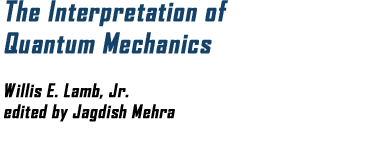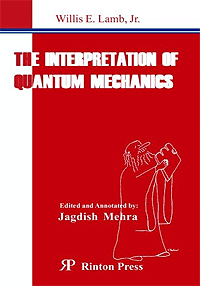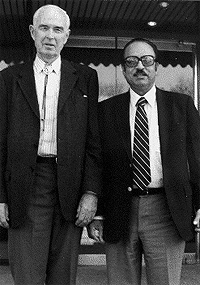| |

|
 |
|
 |
494 pages, 9x6 inches
Oct
2001 Hardcover
ISBN 1-58949-005-3
US$88 |
|
|
|
Buy It |
|
|
 
This book brings
together the various papers and lectures of Professor
Willis E. Lamb, Jr. (who was awarded the Nobel Prize in
Physics in 1955 for his precise measurement of what came
to be called the Lamb shift) on the fundamental,
fascinating, and fashionable subject of the
interpretation of quantum mechanics, to which Professor
Lamb began to bring his original insights since he
started publishing his papers in the filed in 1969. In a
detailed editorial annotation on the `Scientific Work of
Willis E. Lamb, Jr.í (based on extensive conversations
with Professor Lamb), Jagdish Mehra, a distinguished
historian of modern physics, who has published
extensively on the historical development of quantum
theory, provides a survey of Professor Lambís diverse
contributions to the various fields of fundamental
physics and the context in which they were made.
The
Interpretation of Quantum Mechanics
by Willis E. Lamb, Jr., provides all students of quantum
mechanics, physicists, philosophers and historians of
sciences, new insights in the understanding of quantum
mechanics by one of the greatest physicists of the
twentieth century, and the editorial annotation offers a
fascinating portrait of the life and science of a great
man. |

0 Foreword
1 An Operational Interpretation of
Nonrelativistic Quantum Mechanics
2 Von Neumann's Reduction of the Wave Function
3 Remarks on the Interpretation of Quantum
Mechanics
4 Sequential Measurements in Quantum Mechanics
5 Theory of Quantum Mechanical Measurements
6 Schrodinger's Cat
7 Quantum Chaos and the Theory of Measurement
8 Lectures on the Quantum Theory of Measurment I
9 Lectures on the Quantum Theory of Measurment II
10 Quantum Theory of Measurement I
11 Quantum Theory of Measurement II
12 Matter-Field Interaction in Atomic Physics and
Quantum Optics
13 Classical Measurements on a Quantum Mechanical
System |
14 Corrections to the Golden Rule
15 Computational Approach to the Quantum
Zeno Effect: Position Measurements
16 Suppose Newton Had Invented Quantum
Mechanics
17 Anti-Photon
18 The Borderland between Quantum and
Classical Mechanics
19 Classical Theory of Measurement: A Big
Step Towards the Quantum Theory of Measurement
20 Paradoxes of Quantum Mechanics
21 Super-Classical Quantum Mechanics
22 Super-Classical Quantum Mechanics: The
Best Interpretation of Non-Relativistic Quantum
Mechanics
Annotation The
Scientific Work of W.E. Lamb, Jr.
The Scinetific Bibliography of Willis E. Lamb,
Jr. |
|

|
The author
(left), Willis Eugene Lamb Jr., was born
in Los Angeles, California. He earned a Ph.D. in
physics under J. Robert Oppenheimer in 1938 at
the University of California, Berkeley. Lamb has
taught physics throughout his entire career: at
Columbia University; Stanford University;
Harvard University; Oxford University; Yale
University; and the University of Arizona. He
has been a prolific researcher, who has been at
the forefront of research in fundamental physics
during the past over six decades. For his
precise measurement of the fine structure in
hydrogen (the level shift between 2S1/2 and
2P1/2 in early 1947, since then called the
Lamb shift, with his graduate student Robert
Retherford at Columbia University), he was
awarded the Nobel Prize in Physics in 1955,
which he shared with Polykarp Kusch (who had
made a precise measurement of the anomalous
magnetic moment of the electron). Lamb's
contributions to physics are highly honored and
justly celebrated: it was his measurement of the
Lamb shift that led to the renormalized
quantum electrodynamical theories of Schwinger,
Feynman, Tomonaga, and Dyson.
|

The
editor, Jagdish Mehra, was trained as a
theoretical physicist in the research schools of
Werner Heisenberg and Wolfgan Pauli, and later
came under the strong influence of P.A.M. Dirac.
He is the author or editor for many books
including The Historical Development of
Quantum Theory (with H. Rechenberg,
1982-2000), The Collected Works of Eugene
Paul Wigner (with A. S. Wightman,
1993-2000), The Physicist's Conception of
Nature, (1972), The Quantum Principle:
Its Interpretation and Epistemology (1974),
The Beat of a Different Drum (1994),
and Climbing the Mountain (with K. A.
Milton, 2000). Professor Lamb and Professor
Mehra have been close friends for a very long
time. |
|
|
|
|

